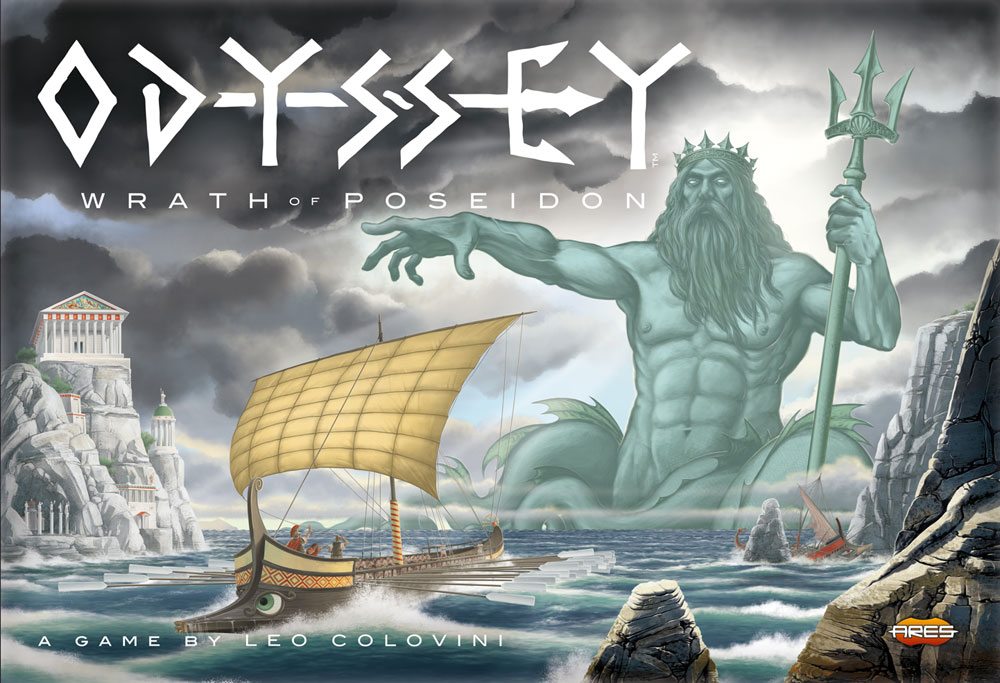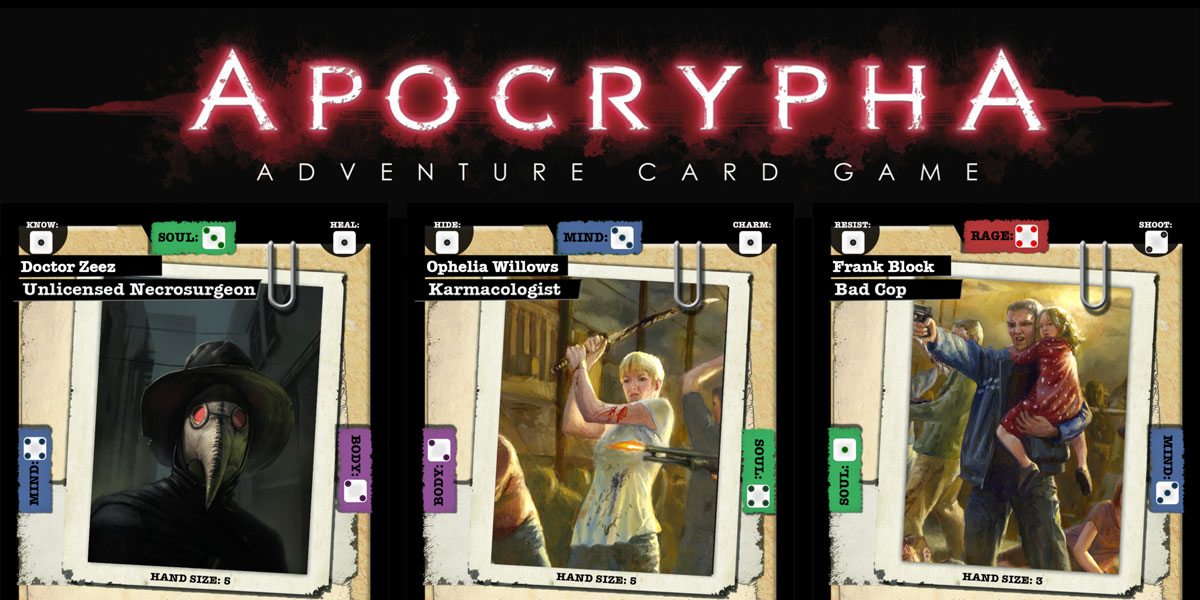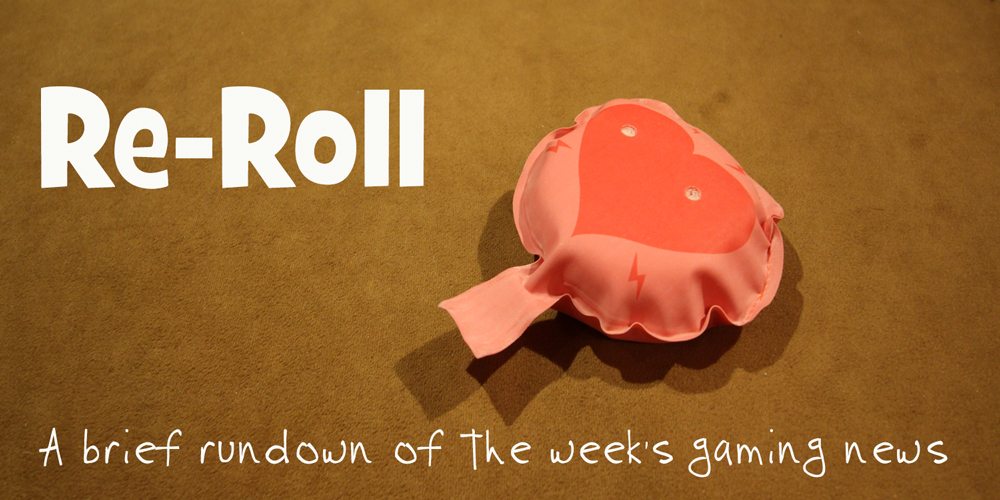With the Trojan War over, the Greeks are trying to get to the Sacred Island to make offerings for a safe journey home. But Poseidon is not pleased, and will use powerful storms to keep them from the island. Odyssey: Wrath of Poseidon pits up to four navigators against Poseidon, who attempts to drive you off course.
At a glance: Odyssey: Wrath of Poseidon is a game for 2 to 5 players, ages 13 and up, and takes about 30 minutes to play. It is available on Amazon for roughly $30, or check your local game store. The game can be played by younger players, and some options let you adjust difficulty per team, so you can easily handicap the game depending on experience level.

Components
- 11 Storm tiles
- 14 Special tiles:
- 2 Sea Monsters
- 4 Lighthouses
- 4 Maelstroms
- 4 Fog Banks
- 16 reminder tokens (4 each in 4 colors)
- 2 Compass Rose tiles
- 8 ships (2 each in 4 colors)
- 4 double-sided map boards (2 copies each of 2 boards)
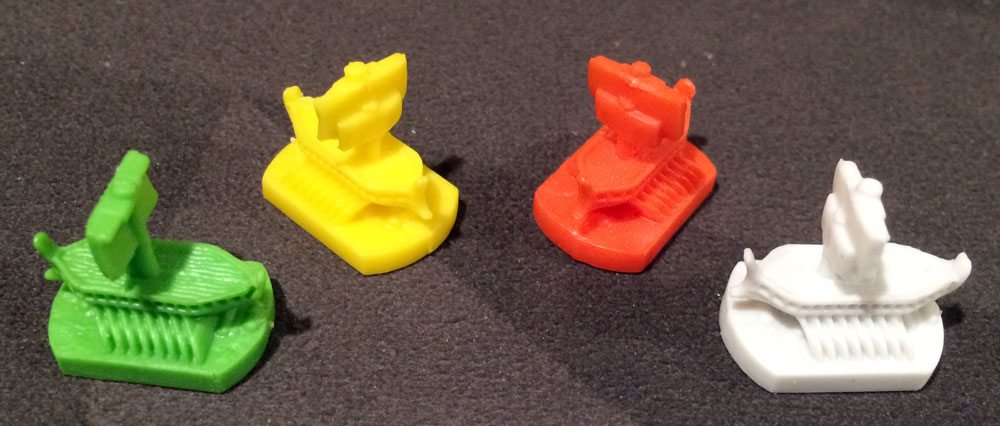
The components for this are nice: the cardboard tiles are all nice and sturdy, and the plastic ship pawns are fun. The Storm tiles and the Sea Monster tiles are all larger squares, and other special tiles and reminder tokens are all small squares, made to fit within the grid spaces printed on the map boards.
There are two copies of each board, and each one is double-sided, so you have options of A, B, C, or D: Poseidon uses one copy, and the navigators use the other copy of the same board. The box insert is designed so that after you take out the components you need, you put the map board back on top, and then use the box lid as a divider wall between Poseidon and the navigators. It works quite well.
The one thing I thought was a little odd and unnecessary was the Compass Rose tiles—they’re large, card-sized cardboard tiles, and all they have on them is, well, a compass rose—presumably so that you can ensure that players know which direction is which. But as there is a compass rose printed on the map boards themselves, it seems quite redundant. Frankly, if you need a separate compass rose card to remind you which direction is northwest, then you will probably have a very difficult time with this game.
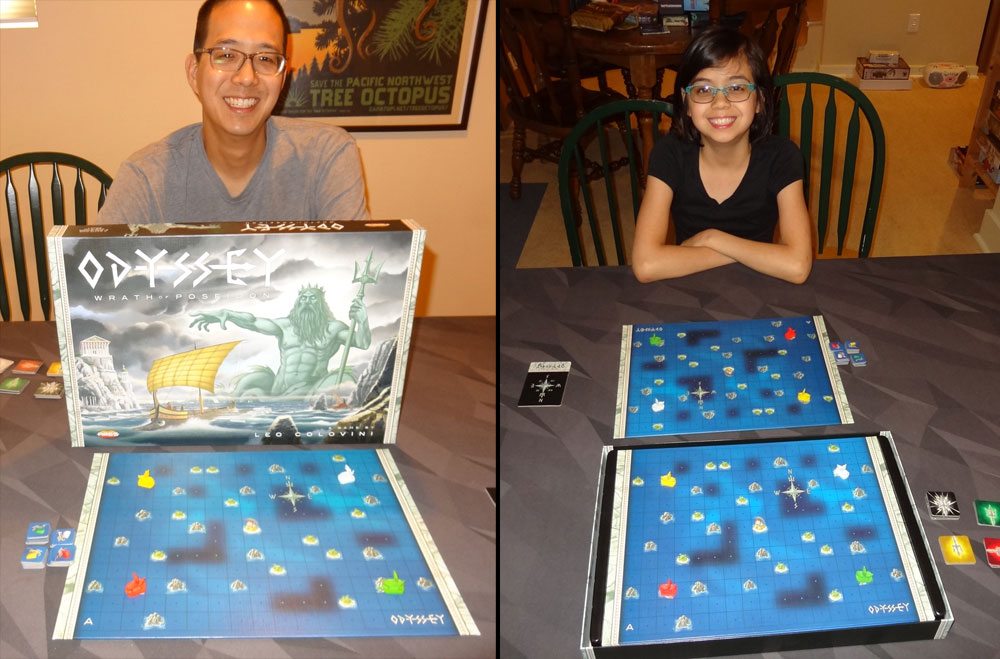
How to Play
You can read the rulebook online or download a PDF here.
One player is Poseidon, and the rest of the players are Navigators. The Navigators are trying to reach the Sacred Island in the center of the board, and Poseidon is trying to throw them off course. Poseidon wins if fewer than 3 boats reach the Sacred Island. The Navigators win if at least 3 boats reached the Sacred Island. (Also, if you have more than 2 players, any individual Navigator who reaches the Sacred Island can also win individually even if the team as a whole loses to Poseidon.)
I’ll describe the rules for a 2-player game; for more players, you divide up the ships among the Navigator players.
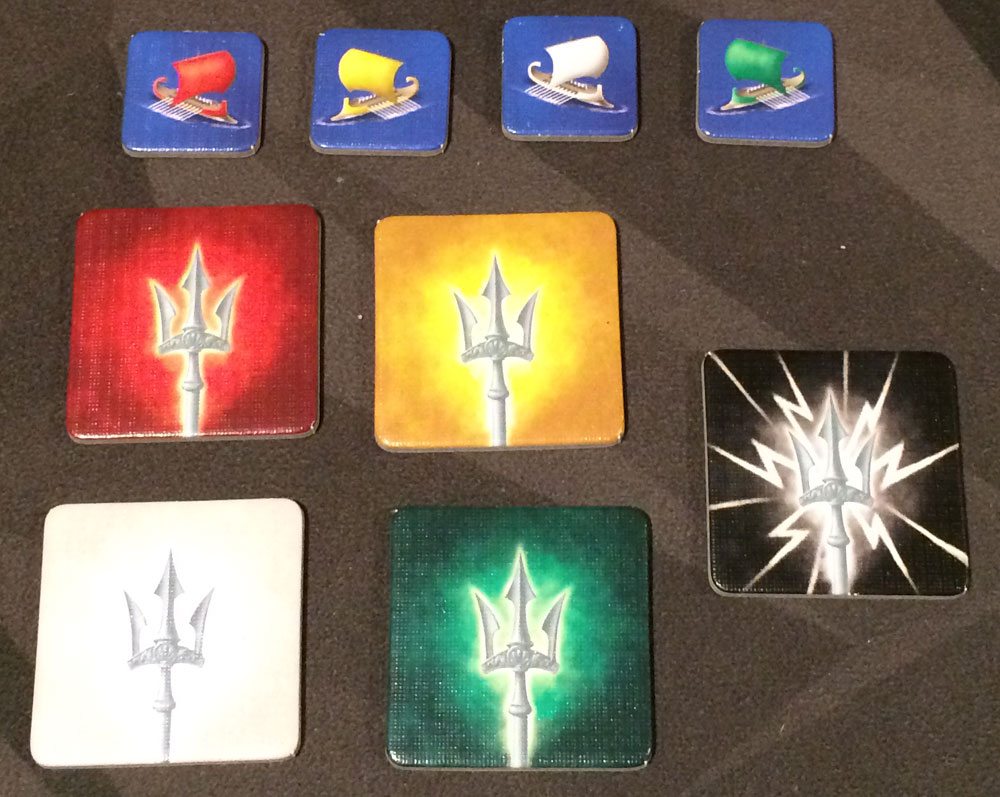
To setup, pick which board you’ll be using, and give one to the Navigator and one to Poseidon. Give each player one set of boats. Poseidon takes the storm tiles and the Navigator takes the ship reminder tokens. Use the box lid to separate the two players, so neither player can see the other player’s board. Put the ships on the starting islands (marked with the colored ships).
Each round starts with Poseidon’s turn, then the Navigator’s turn.

Poseidon must play one of the storm tiles: there are tiles in the four ship colors, as well as black storm tiles. If you play one that matches a ship, you move that ship one space in any direction (orthogonally or diagonally). If you play a black storm tile, you move all four ships one space each. Note that you only tell the Navigators which storm tile you played, but not which direction you moved things. You may not use black storm tiles twice in a row. Tiles are discarded and placed so that both players can see which ones have been played.
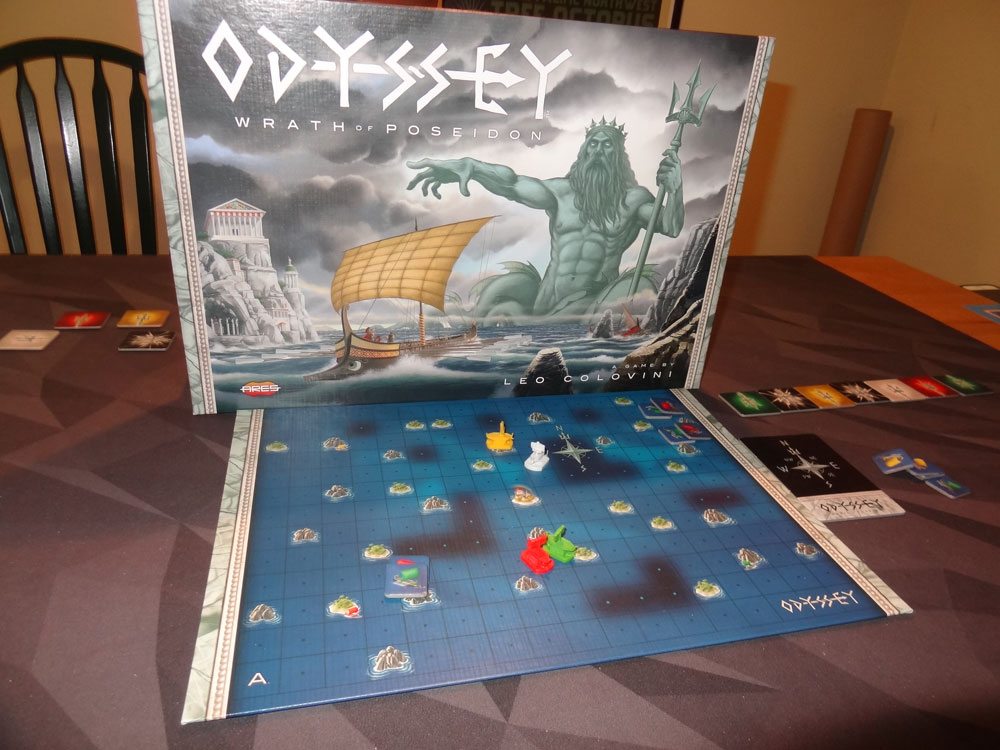
For the Navigator, each ship gets a movement and survey—ships may be activated in any order. First, the Navigator may move the ship one space in any direction, announcing the direction. Poseidon (who knows where the ship really is) also moves the ship in the chosen direction on his own board.
Then the ship performs a survey: Poseidon must announce what the ship sees in its sighting area (the eight spaces surrounding the ship) and in its exploring area (the space the ship is on). Poseidon tells the Navigator how many islands or ships are in the sighting area but not what color or type. Then Poseidon tells the Navigator if the ship is in deep water (the dark blue spaces), or on an island—if on an island, Poseidon says what type of island (woody, rocky, or Sacred). Finally, if there are other ships in the same space, Poseidon announces what color the other ships are.
Ships cannot be moved off the edge of the board (Poseidon just tells the Navigator and they ship doesn’t move), and if a ship is on the edge of the board, Poseidon would say “the coastline is in sight.” Once a ship reaches the Sacred Island, it has achieved its goal and will no longer be moved by Poseidon or the Navigators, but it remains on the island and can be spotted by other ships during the survey step.
Navigators may use the reminder tokens to try to mark possible locations of their ships.
Once all four ships have been activated, it is Poseidon’s turn again.
The game ends at the end of 11 rounds, when all of the storm tiles have been played.
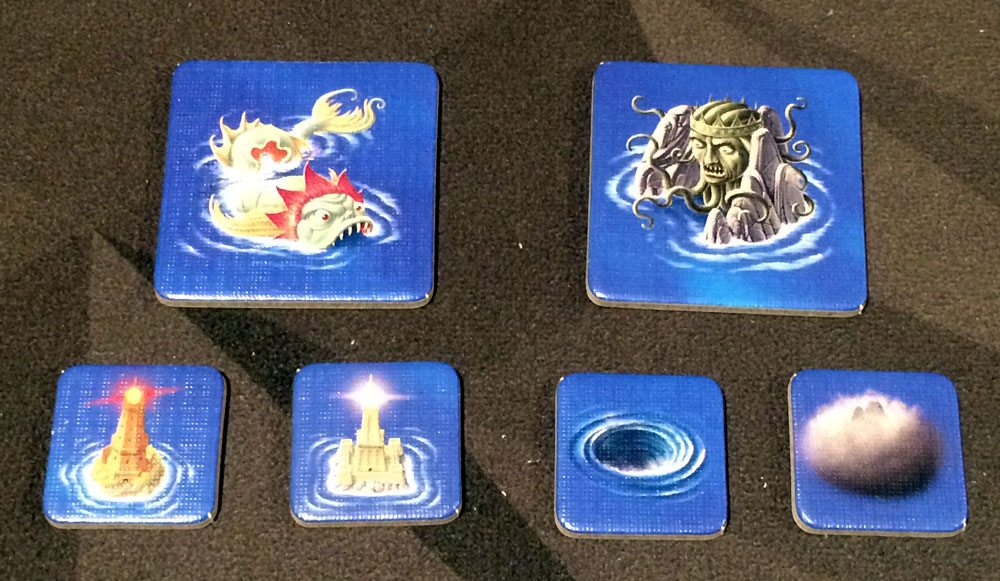
There are some variants, too, in case you want to make the game easier or harder for either player. Sea Monsters can be added to the storm tiles to prevent a ship from moving for one turn. Lighthouses may be placed before the game begins to give Navigators one more point of reference. Maelstroms allow Poseidon to move a ship one extra space if a ship encounters one. Fog Banks obscure a ship’s sight, so they can’t see what was supposed to be there, and can’t even see other ships who are in the same fog bank.

The Verdict
I really like hidden movement games like Scotland Yard or Letters From Whitechapel: they usually pit one person against the rest of the players, with the single person hidden and trying to hide from everyone else. The seekers have ways of picking up clues, and try to narrow down the search before the hidden player can escape. Odyssey puts a new spin on hidden movement: in this case, the hidden player is actually moving the seekers themselves; the seekers aren’t looking for the hidden player, but trying to figure out where they are themselves.
I’ve played this with my daughters, who are both under the recommended age range, but they both really enjoyed it. My 9-year-old particularly likes playing as Poseidon, and has even beaten me as Poseidon a couple of times. What I’ve found is that there’s not that much room for error with the Navigators in the default game. In 11 rounds, if Poseidon always moves you away from the Sacred Island, you’ll have exactly enough moves to get there if you always choose correctly. Of course, that doesn’t make for a very interesting game, and if the Poseidon player always does the same thing, it will be easily overcome.
I recommend using the variants to tune the game depending on which player has more experience—if the Navigator is always losing, then use the lighthouses to help them find their way. If they keep finding the Sacred Island, throw in a few fog banks or maelstroms to keep them mixed up.
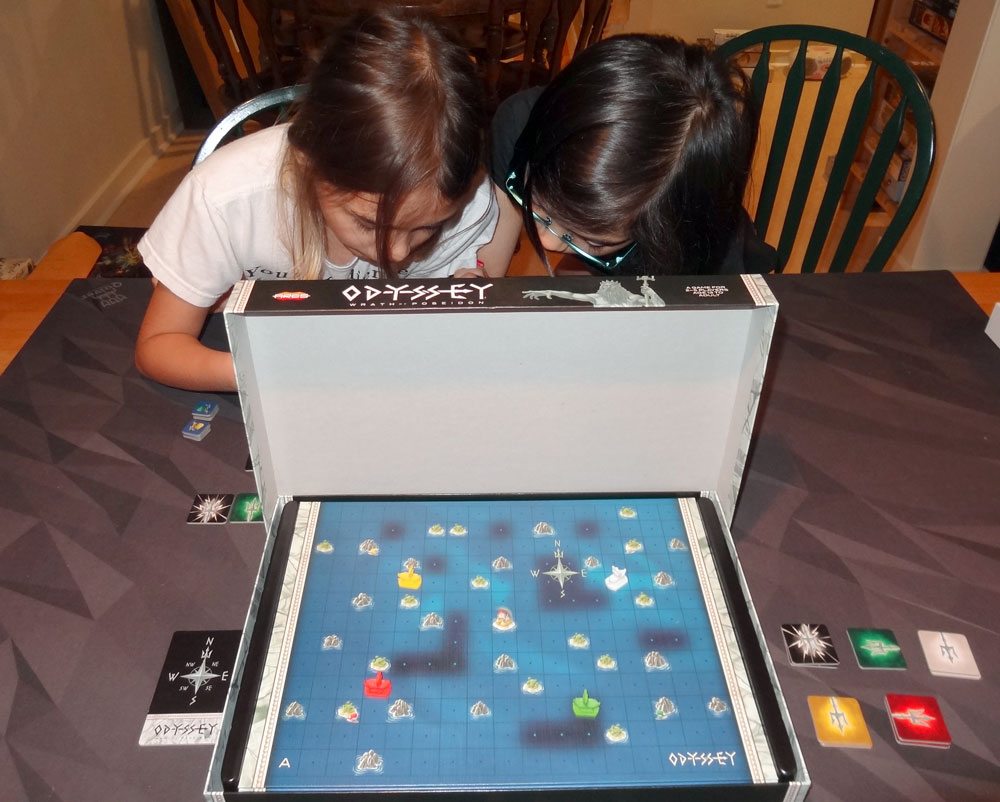
I think it’s generally more fun to be Poseidon, because you’re in control—you get to manipulate the other players behind your screen, moving them around in the hopes of getting them totally lost. There is some strategy in trying to predict which way the Navigator may want to move, and then putting the ship in a place that makes it hard to figure out where they are from the survey. In some spots on the board, they might see 2 islands in the sighting area, and then realize that there are three possible locations where that is possible. If they’re unable to pin the location down quickly, then another storm can completely throw them off the path. It’s important to note, though, that Poseidon doesn’t get to look at the Navigator’s board, either, so you never know for sure how far off the Navigators are from their actual location. As a Navigator, I’ve found a few strategies to help narrow down my location, and it helps to have a system with the reminder tokens, or else you’ll forget which locations you think are more likely than others.
Odyssey usually doesn’t take too long—it’s only 11 rounds—although it does depend on how long each player spends on their turn. Poseidon’s turns are usually fairly quick, of course, but Navigators may spend a lot longer puzzling over possibilities.
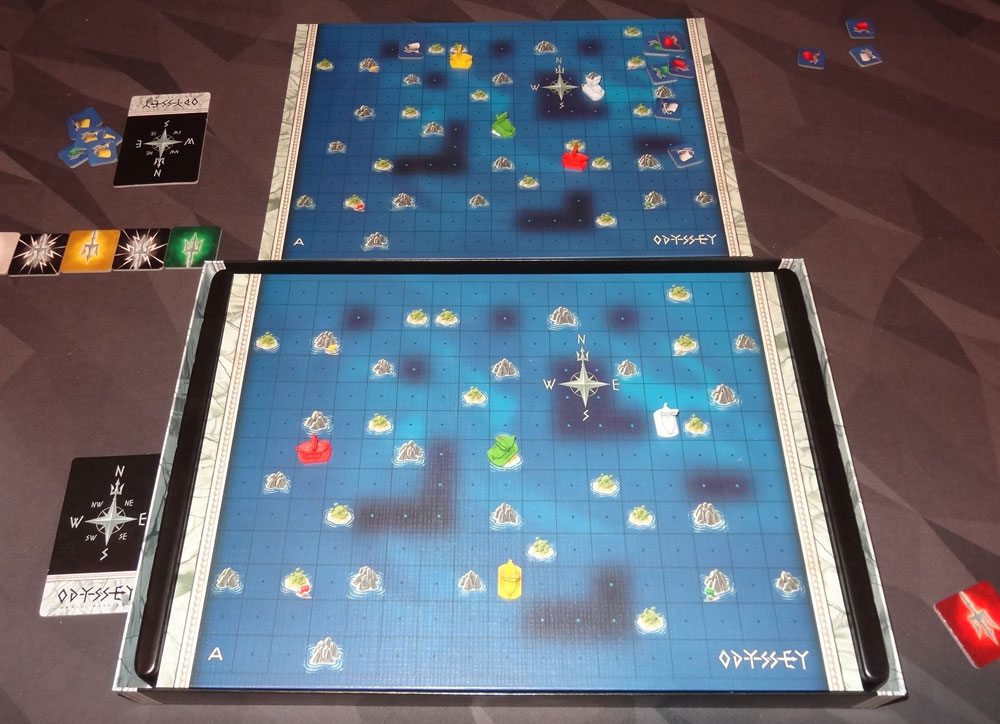
If you like hidden movement and deduction games, you should check out Odyssey: Wrath of Poseidon. The multiple boards give you some variety each time you play, and players will have fun taking turns getting lost at sea.
Disclosure: I received a review copy of this game.
